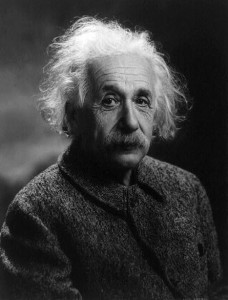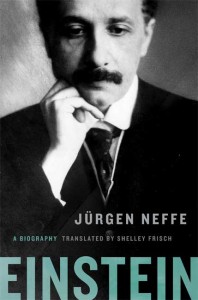By Dr. Jürgen Neffe

Since 1934, Leo Szilard had been pondering the possibility of neutron chain reactions and the massive explosions that would result. While Einstein purportedly still doubted whether atomic bombs could be built at all, the press was shouting the news from the rooftops. “Physicists Here Debate Whether Experiment Will Blow Up Two Miles of the Landscape,” The Washington Post reported on April 29, 1939.
Against this backdrop, Einstein, who was being pressured by Szilard, took the step he would rue more than any other in his life—writing his legendary letter to the president of the United States. His role in the development of the atomic bomb ended at this point, however. Roosevelt appointed a commission, but it had very limited means at its disposal and only an advisory function. Even if Einstein had wanted to collaborate on the project, they would not have let him do so. As we know from a dossier on which FBI director J. Edgar Hoover based his decision not to allow Einstein’s participation in 1940, he was thought to pose a heightened security risk.
In this dossier, Einstein’s summerhouse in Caputh was portrayed as “the Einstein villa at Wannsee” and “the hiding place of Moscow envoys,” and his support of the November 1937 conference of the American League Against War and Fascism was cited as evidence of subversive activity. American policies of the time were happy to turn a blind eye to right-wing movements, because they needed Germany and other fascist countries as a bulwark against Bolshevism. Their left eye was wide open, however, and any involvement as a pacifist was enough to get someone classified as a leftist.
At first, Einstein took this suspicion of communism lightly. “It is easy to see that E. is in Princeton,” he quipped in 1937 in a letter to Maja, “recently a P. University publication featured a red cover.” He soon lost his taste for jokes of this kind.
“In view of his radical background,” the FBI document stated in summary, “this office would not recommend the employment of Dr. Einstein on matters of a secret nature.” The pivotal primary source the FBI used to support this position was the sixteen-page pamphlet with which the Woman Patriot Corporation tried to block his entry into the United States in 1932. Fred Jerome has established that this pamphlet amounted to 80 percent of the dossier.
Even though he probably never learned of his official exclusion from work on the atomic bomb, Einstein must have noticed that a gigantic government project was being launched. Most of the well-known physicists, including many of his fellow exiles, suddenly seemed to disappear. Although even his friends by and large kept their new project under wraps, he surely knew what they were toiling away at.
Why participation was denied specifically to Einstein remains an FBI secret. The only document from his file to disappear without a trace was the letter that spelled out the reasoning behind this decision. Hoover’s blatant hostility to Einstein’s alleged communist affiliations, or his more subtle aversion to Einstein’s Judaism stemming from Hoover’s own anti-Semitism, could not have been the sole deciding factors. Quite a few researchers on the secret Manhattan Project had far stronger ties to communist groups, and without the involvement of many Jewish immigrants, the undertaking would have failed in any case.
The marines had no qualms about allowing Einstein to participate in the development of torpedoes for the sum of twenty-five dollars a day, and he had no illusions about his role in this effort: “I am curious,” he wrote to his son Hans Albert, “whether I will be able to accomplish something for the Navy before the war is over; as a recluse, I am somewhat cut off.” His more significant contribution to the military effort was monetary. Einstein copied out the manuscript of his theory of relativity and had it auctioned off for $6.5 million; the proceeds went to the war chest. This valuable document is housed in the Library of Congress today.
The FBI man and the physicist were poles apart on the issue of the role of the United States in World War II. Hoover, a secret Nazi sympathizer with ties to the head of the Gestapo, Heinrich Himmler, stood on the side of the isolationists until late 1941 and hence against an American entry into the war. Einstein, by contrast, once he was farsighted enough to predict the German war of conquest and put aside his pacifism, knew that America was the only nation powerful enough to combat sweeping Nazi victories, a conviction he shared with Thomas Mann, who regarded Roosevelt as the “born opponent . . . of the creature that must be toppled.”
After the Japanese attack on the United States Pacific Fleet in Pearl Harbor and the American entry into the war in late 1941, the Americans stepped up their work on the atomic bomb. The fact that it would later hit Japanand not Germany, which is the only target Einstein would have condoned, was in his view the greatest catastrophe in these times of great catastrophes. The key decision to build the bomb ultimately had nothing to do with the Japanese attack. It was made on December 6, 1941—one day before Pearl Harbor.

Excerpted from Einstein: A Biography by Jürgen Neffe.
Copyright © 2005 by Rowohlt Verlag. Translation copyright © 2007 by Shelley Frisch. Reprinted by permission of Farrar, Straus and Giroux.
All rights reserved. This work is protected under copyright laws and reproduction is strictly prohibited. Permission to reproduce the material in any manner or medium must be secured from the Publisher.
For more information about the letters, and to view digitized versions, visit: Atomic Letters: Einstein, Roosevelt, Sachs.
DR. JÜRGEN NEFFE is the author of Einstein: A Biography and a recipient of the Egon Erwin Kisch Award, the most prestigious award for print journalism in Germany. He lives in Berlin, where he is affiliated with the Max Planck Institute for Science History.
